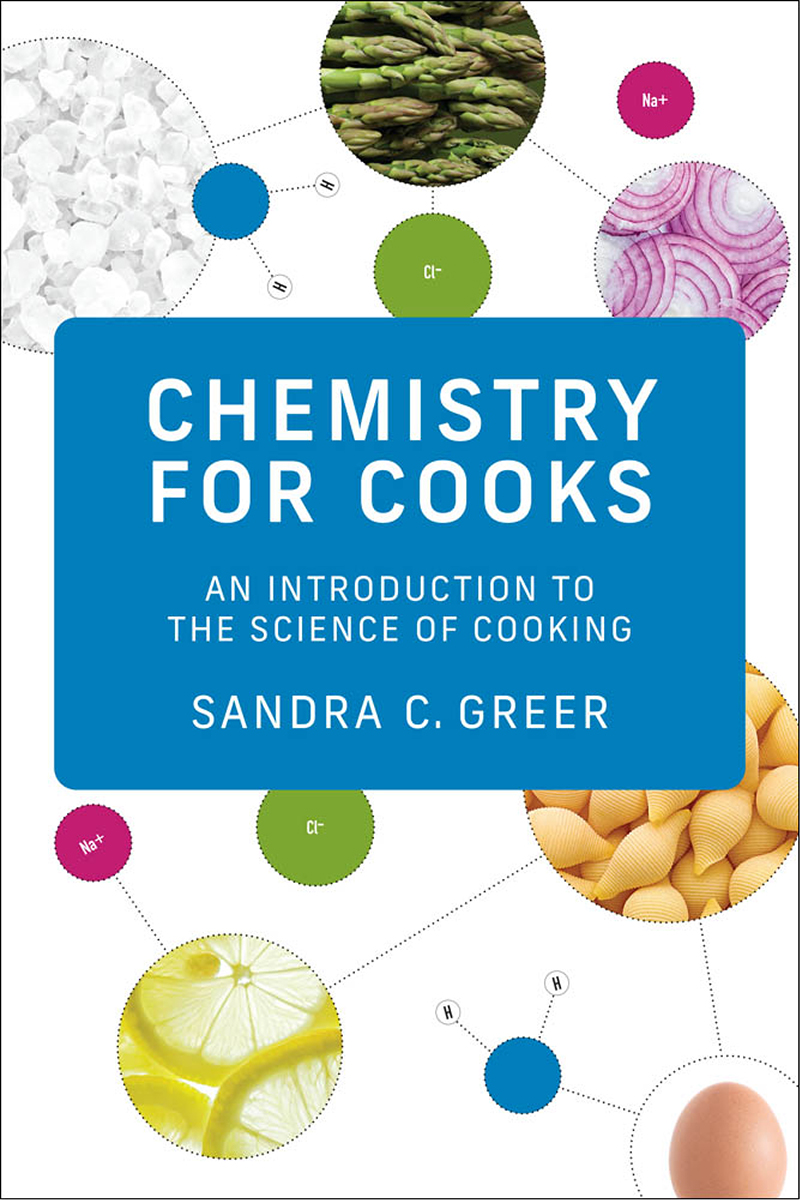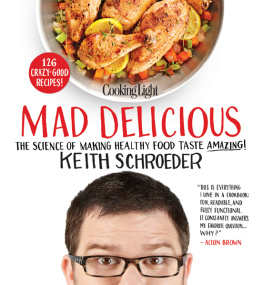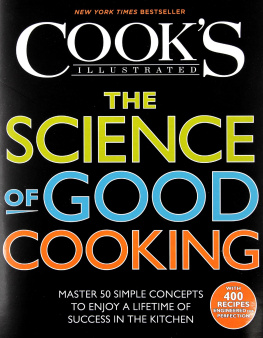
Chemistry for Cooks
Chemistry for Cooks
An Introduction to the Science of Cooking
Sandra C. Greer
The MIT Press
Cambridge, Massachusetts
London, England
2022 Massachusetts Institute of Technology
All rights reserved. No part of this book may be reproduced in any form by any electronic or mechanical means (including photocopying, recording, or information storage and retrieval) without permission in writing from the publisher.
The MIT Press would like to thank the anonymous peer reviewers who provided comments on drafts of this book. The generous work of academic experts is essential for establishing the authority and quality of our publications. We acknowledge with gratitude the contributions of these otherwise uncredited readers.
This book was set in ITC Stone Serif Std and ITC Stone Sans Std by New Best-set Typesetters Ltd.
Library of Congress Cataloging-in-Publication Data
Names: Greer, Sandra C., 1945- author.
Title: Chemistry for cooks : an introduction to the science of cooking / Sandra C. Greer.
Description: Cambridge, Massachusetts : The MIT Press, [2022] | Includes index.
Identifiers: LCCN 2022000773 (print) | LCCN 2022000774 (ebook) | ISBN 9780262544795 (paperback) | ISBN 9780262372589 (pdf) | ISBN 9780262372596 (ebook)
Subjects: LCSH: CookingExperiments. | FoodComposition. | Chemistry, Technical.
Classification: LCC TX545 .G74 2022 (print) | LCC TX545 (ebook) | DDC 664/.07dc23/eng/20220725
LC record available at https://lccn.loc.gov/2022000773
LC ebook record available at https://lccn.loc.gov/2022000774
10987654321
d_r0
Dedicated to
Andrew Greer,
Enrico Rotelli,
Michael Greer,
Kaliel Roberts,
Arlo Greer,
Mack Greer,
Melina Murray,
Gwendolyn Bush,
Judith Chandler,
Janet Holmgren,
Gail Locke,
Patricia Miller,
Margaret Palmer,
Sue Rosser,
and Linda Richards,
and to the love that we share in the kitchen and around the table.
Contents
Preface
Cooking was probably the greatest [discovery], excepting language, ever made by [humans].
Charles Darwin, The Descent of Man, and Selection in Relation to Sex
Charles Darwin, one of the greatest scientists of all time, recognized that the cooking of food changed human history. The reasons for the impact of cooking all involve science. Cooking makes food easier to eat and to digest by using heat or chemicals to change the structure of plant or animal tissue, to release nutrients from the food cells, and to break food molecules into smaller, more digestible pieces. When we human beings can make better use of food sources, then we can spend less time obtaining food and more time on other activities.1 In addition,
- Cooking kills germs by heating or otherwise treating food so that microorganisms die.
- Cooking can destroy poisonous chemicals that make food inedible.2
- Cooking preserves food by changing the enzymes that cause food to decay.3
- Cooking makes food taste and smell better by causing chemical reactions that improve flavors and textures, by releasing aromas, and by adding salt, spices, and herbs.
Chemistry for Cooks is a science textbook for undergraduate college students and for high school students. It is meant for students who are not science majors, and no background knowledge in science is needed. Everything you need to know is explained in the book. General readers, home cooks, culinary students, and professional cooks will find the text understandable. Anyone who likes to cook and wants to understand cooking better will find this book helpful.
The goal of this book is for you, the reader, to learn some science, so that you will:
- Understand what matter is made of and how the structure of matter is altered by heat, by interactions among molecules, and by reactions that change molecules;
- Understand how to treat food in order to change its microscopic structure and make it more delicious and more digestible;
- Learn to ask why a particular procedure or method is used and to think critically about what you do in the kitchen;
- See cooking as an enjoyable and interesting application of science.
While the title says chemistry, the world does not neatly divide into topics of chemistry and biology and physics, so we will also need to include some biology and a bit of physics. Chemistry for Cooks is set at a level between the books written for the home cook that include some science,4,5 and the books written for the professional food scientist that assume a full background of coursework in science.6,7 There are also culinary science books that are about trying different things to see what works best in the kitchen, but that is not science. Kitchen experiments become science only when the result is an understanding of why something works, not just what works. An understanding of the underlying science will make cooking more rational and less rigid, more adventurous, and even more fun.
We will begin with a brief introduction of what matter is made of, namely atoms and molecules. If you already know this basic material, you can skim over the first chapter. Do read the section in chapter 1 on the important food ingredient, salt (sodium chloride). Then the next chapters cover the other key topics of water, heat, acids and bases, carbohydrates, fats and oils, and proteins. Later chapters explain important reactions (Maillard, fermentation), colloidal dispersions (emulsions, suspensions, gels), diffusion and osmosis, the basics of nutrition, and the effects of food on the senses.
There is a recent trend in cooking that is called molecular gastronomy or modernist cuisine.812 This trend came from a group of chefs, scientists, and food writers who were interested in understanding the scientific principles of cooking with laboratory devices such as constant-temperature baths, foam dispensers, liquid nitrogen freezing, and so on. Chemistry for Cooks shares with molecular cuisine the goals of understanding the science behind cooking and of being willing to rethink culinary traditions in the light of the science. It also shares the goal of using some simple scientific tools (such as digital thermometers) to improve cooking. However, this book will take a more traditional approach to cooking and to kitchen equipment.
Chemistry for Cooks is not a cookbook, but it does include recipes. Each chapter includes two cases of Recipe Analysis, in which a recipe is closely considered using the scientific principles in this book. Each chapter ends with Kitchen Hints that are useful ideas based on the content of that chapter. Each chapter includes exercises for the student, and also topics for projects that require more research and thought than do the exercises. While Chemistry for Cooks is not designed to support a laboratory course, many of the projects involve kitchen exercises that may be used at the discretion of the instructor. More resources for instructors are provided on the publishers website and include a solutions manual, a sample course syllabus, and PowerPoint slides for all the figures and tables.
You do not need any other books to use this book, but the references at the end of each chapter will allow you to read more about any subject that piques your interest. If you want to start your own shelf of books for cooking, I recommend that you start with two books (besides this one!). First, Harold McGees On Food and Cooking: The Science and Lore of the Kitchen
Next page






